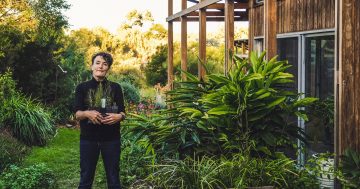
‘Micro-forest maker’ Edwina Robinson wanders through the Downer micro-forest. Photo: Jarra Joseph-McGrath.
After her successes in Downer and Watson, Canberra’s ‘micro-forest maker’ Edwina Robinson has shifted her attention to the Eurobodalla.
Inspired by wanting to address the hottest and driest year on record (2019) from a community level, Edwina started works on the Downer micro-forest in 2019 as part of her social initiative, the ‘Climate Factory’. The initial response suggested there was a strong demand within the community.
“I ran a crowd-funded campaign and raised a bit over $20,000, and the community in Downer also applied for a government grant so we had about $35,000 altogether,” Edwina said.
“So we built an 1800-plant micro-forest using the `Miyawaki’ method.”
A renowned Japanese botanist and expert in plant ecology, Akira Miyawaki’s micro-forest method sees the forest grow at a rate 10 times faster than in nature.
Edwina wanted to replicate this but also make adjustments to accommodate for the heat of the Australian sun, which included securing water for the forest.
“We couldn’t just be planting native plants into the ground and not securing some water for them,” she said.
“So I worked with water harvesting designer Paul Totterdell who has this system where he can create trenches under the ground so he’s intercepting water falling on the surface.
“The idea is that water goes down into those trenches and is stored in the voids of the gravel and then leaks out into the surrounding soil.”
The success of the Downer project was easy for all to see and it wasn’t long before people eager to bring a similar project to their own community began approaching Edwina.
Realising the interest she’d sparked, Edwina created a model for others to follow: “Eight Steps to Make a Community Micro-Forest”.
After more than 30 years living in Canberra, Edwina now spends most of her time in Moruya. Following the bushfires and emerging from the pandemic, she believes the time is right to bring a micro-forest to the Eurobodalla.
“Post-fires and post-pandemic, I just kept thinking we should do one down here and use coastal rainforest species less likely to burn,” she said. “Then I also found out some of those coastal rainforest species are endangered ecological communities.
“A big part of the Eurobodalla burnt because of those fires and we lost a lot of vegetation. We’re also seeing a lot of vegetation being removed for new developments.
“What we do has a really strong community building and community empowering element to it. I think people are really tired because of the last couple of years and they’re sick of not being able to hang out with one another.”
Edwina expects the Eurobodalla could present a fresh set of challenges to forming the micro-forest, especially if there’s a significant difference in soil.
“In Canberra, the sites we’ve been dealing with are mostly clay. So if you’re doing water harvesting in clay soil, you don’t have to worry about using geotech style fabric or liners for the trenches.
“We may have to do that, depending on what we find, especially if we get sandy soil.”
Mimicking how she started the Canberra projects, Edwina is asking Eurobodalla residents if they’re interested in helping her out. So far, 13 people have registered their interest and she’s begun talks with Eurobodalla Shire Council.
Edwina is looking for about a 1200m2 block on public parkland. She hopes to incorporate local rainforest species, an opening gathering space, water harvesting to water beds during drought, paths and nature play.














